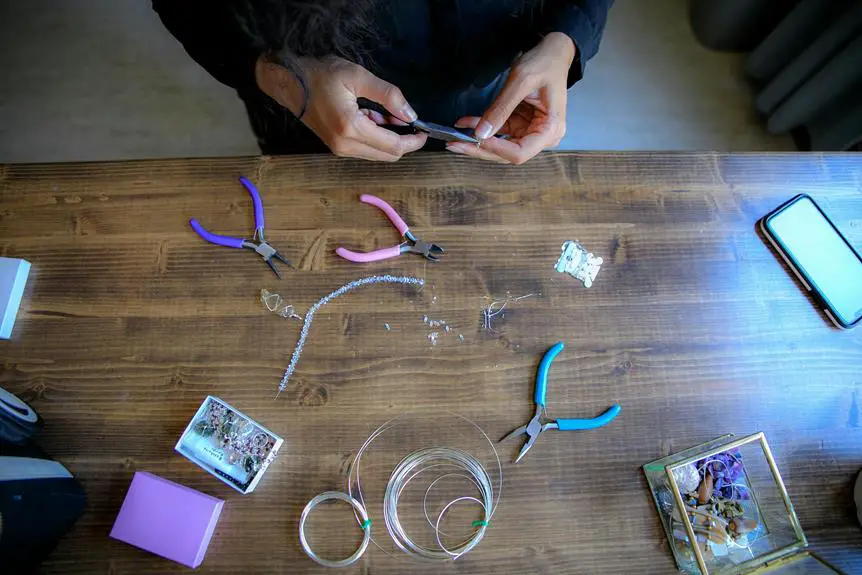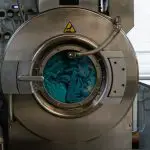If you've ever wondered about the secret behind creating stunning, durable jewelry pieces, look no further than the right adhesive. Finding the best adhesives for jewelry making can be a game-changer, allowing you to expertly craft and secure intricate designs with confidence.
Whether you're working with metal, beads, gemstones, or polymer clay, the perfect adhesive can make all the difference in the longevity and quality of your creations. Understanding the various types of adhesives and their specific applications is essential for mastering the art of jewelry making.
So, let's delve into the world of adhesives and discover the top choices for different jewelry materials, equipping you with the knowledge to elevate your craftsmanship.
Key Takeaways
- Epoxy resin adhesive and cyanoacrylate are popular choices for jewelry making.
- Consider factors such as material compatibility, strength, and drying time when choosing adhesives.
- Epoxy adhesives are recommended for metal jewelry, while E6000 Jewelry and Bead Adhesive and Beacon Gem-Tac Permanent Adhesive are recommended for beaded jewelry.
- It is important to clean bonding surfaces before applying adhesive and to use appropriate bonding techniques for durability.
Types of Adhesives for Jewelry Making
When making jewelry, you should consider using different types of adhesives to ensure a strong and durable bond for your pieces. There are several types of adhesives commonly used in jewelry making, each with its own unique characteristics and benefits.
Epoxy resin adhesive is known for its exceptional durability and is often used to bond metal, stone, and glass components. It requires precise mixing and careful application techniques for optimal results.
Another popular adhesive is cyanoacrylate, commonly known as super glue. This adhesive is fast-drying and suitable for bonding non-porous materials such as metal and glass. It's essential to apply this adhesive sparingly to avoid unsightly residue or fogging on delicate jewelry components.
When considering the types of adhesives for jewelry making, it's crucial to weigh the adhesive's durability against its cost. While some adhesives may be more expensive, they may offer superior bonding strength and longevity, ultimately ensuring the quality and longevity of your jewelry pieces.
As you explore different adhesives and application techniques, consider conducting a cost comparison to determine the most suitable option for your specific jewelry-making needs.
Factors to Consider When Choosing Adhesives
As you embark on your jewelry-making journey, it's important to consider several factors when choosing adhesives for your projects. Selecting the right adhesive is crucial for ensuring the durability and quality of your jewelry pieces. Here are some key factors to consider and application techniques to keep in mind:
| Factors to Consider | Application Techniques | Compatibility |
|---|---|---|
| Adhesive Type | Pros | Cons |
| Epoxy Resin | Provides strong bond | Requires mixing and curing |
| Cyanoacrylate | Fast bonding time | Can be brittle |
| Polyurethane Glue | Water-resistant and flexible | Takes longer to cure |
| UV Resin | Cures quickly under UV light | Requires special equipment |
Each adhesive type offers unique benefits and drawbacks, so it's important to consider the specific requirements of your polymer clay project. Whether you're attaching metal findings, setting gemstones, or joining clay components, selecting the right adhesive is crucial for the longevity and durability of your jewelry pieces. Experiment with different adhesives to find the best fit for your polymer clay jewelry creations.
Specialized Adhesives for Unique Jewelry Materials
Exploring adhesives for unique jewelry materials involves considering the specific properties and requirements of each material, ensuring secure and lasting bonds for your creations. When working with specialized jewelry materials such as polymer clay and gemstones, it's crucial to choose adhesives that are tailored to their unique characteristics.
Here are some specialized adhesives to consider for these materials:
- Polymer Clay Adhesive: Look for adhesives specifically formulated for bonding polymer clay. These adhesives are designed to create strong and durable bonds without damaging the clay's texture or finish.
- Gemstone Adhesives: Gemstones often require delicate handling due to their unique properties. Opt for adhesives that are safe for use with gemstones and provide a secure hold without affecting the stone's color or luster.
- UV Resin: This specialized adhesive is ideal for creating transparent and permanent bonds, making it suitable for intricate jewelry designs that require a clear, glass-like finish.
- Epoxy Resin: When working with a combination of materials, such as gemstones and metal findings, epoxy resin provides a strong and versatile bonding solution, ensuring your jewelry pieces withstand everyday wear and tear.
Selecting the right adhesive for your unique jewelry materials is essential for achieving professional, long-lasting results in your jewelry making endeavors.
Frequently Asked Questions
Can Adhesives Be Used to Attach Gemstones to Metal Jewelry, or Are There Specific Techniques or Tools That Should Be Used Instead?
When attaching gemstones to metal jewelry, consider adhesive alternatives like prong or bezel settings. These techniques provide secure and professional-looking results. Using specific metal jewelry techniques ensures durability and aesthetic appeal without relying solely on adhesives.
Are There Any Adhesives That Are Safe for Use on Delicate Gemstones or Pearls Without Causing Damage?
When working with delicate gemstones and pearls in jewelry making, it's crucial to use safe adhesives to prevent damage. For polymer clay jewelry or unconventional materials, consider specialized adhesives designed for their unique properties.
How Do I Know if a Particular Adhesive Is Suitable for Use With Polymer Clay Jewelry, and Are There Any Special Considerations to Keep in Mind?
When choosing adhesive for your polymer clay jewelry, consider its compatibility with the material and any special considerations. For gemstone attachment or metal jewelry techniques, ensure the adhesive is suitable and won't cause damage.
Are There Any Adhesives That Are Specifically Designed for Use With Unique or Unconventional Jewelry Materials, Such as Wood, Fabric, or Resin?
For fabric jewelry, look for adhesives labeled as suitable for fabric and jewelry making. When working with wood jewelry, opt for adhesives designed for wood bonding. These specialized adhesives ensure a strong and durable hold for unconventional materials.
What Is the Best Way to Remove Excess Adhesive From Jewelry Without Causing Any Damage to the Materials?
To remove excess adhesive from jewelry without damage, gently scrape the area with a plastic tool or toothpick. Use a small amount of acetone or rubbing alcohol on a cotton swab for stubborn residue, then clean the piece thoroughly.
- Tetron Fabric for Marine Applications: Durability and Use Cases - June 18, 2025
- Tetron Fabric for Outdoor Furniture: Weather Resistance and Care - June 18, 2025
- Tetron Fabric for Wall Coverings: Style and Application Tips - June 18, 2025







